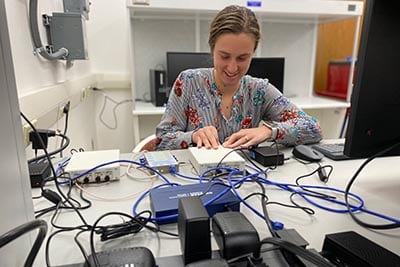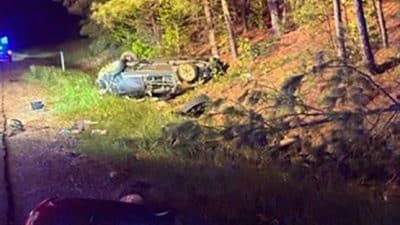
The goal of satellite internet projects is to provide high-speed, low-latency broadband internet across the globe. However, there are still some big questions that need to be answered — including how to build a resilient, secure network in space.
To examine such questions, Commonwealth Cyber Initiative researchers at Virginia Tech have partnered with the University of Surrey in the United Kingdom to build the world’s first hardware-in-the-loop test bed that emulates the changing connectivity of a mega satellite constellation at scale. The researchers introduced the test bed at an intercontinental workshop earlier this month.
“We wanted to establish a shared community vision and brainstorm about what would be possible and what would be most useful in a space networking infrastructure,” said CCI researcher Jonathan Black, professor of aerospace engineering.
Besides uniting researchers and funding agencies on both sides of the Atlantic, the interdisciplinary workshop involved members of the satellite and aerospace community.
“In order to repair, upgrade, and refuel in space, we need to build for efficiency and disruption,” said Ella Atkins, incoming department head for the Kevin T. Crofton Department of Aerospace and Ocean Engineering. “By grounding communications and networking in long-term space robotics, our researchers are building the future of space engineering.”
According to Atkins and Black, the future of space engineering requires effective communication — and the next step is connecting satellite networks.
On the ground, network internet service providers are interconnected. A Verizon network user can talk with someone on an AT&T network, for instance. Communication bounces between networks.
In space, however, communications are siloed. The mega constellations of satellites that comprise different space networks don’t talk to each other — not between orbits, not between networks, and not between individual satellites.
With support from the CCI, the Virginia Tech team and its partners have been researching new space-based, high-bandwidth networks. The test bed they developed over the past year will be simulating mega internet constellations, including satellites, ground stations, connected devices such as phones, and the links between them all.
“We have on the order of thousands of spacecraft being simulated as nodes,” said Samantha Parry Kenyon, VT research associate and co-principal investigator on the CCI project. “We can physically communicate with hardware nodes and directly incorporate them with the virtual satellite nodes from the simulation.”
By running the test bed through different scenarios, the team is looking at what to do when operations are disrupted by something like a space event or a security breach and how an adjacent satellite network could compensate for a compromised system.
With help from the Virginia Tech Integrated Security Education and Research Center, the team plans to open up the test bed’s reference architecture and allow other Commonwealth Cyber Initiative institutions, researchers, educators, and students to examine and optimize paths to inter-constellation connectivity.
With the ability to model constellations on the scale of Starlink, the researchers will be able to design resilient, secure, interconnected networks — both hardware and software.










